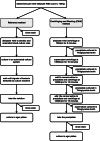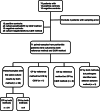Repeated centrifuging and washing concentrates bacterial samples in peritoneal dialysis for optimal culture: an original article
- PMID: 33246404
- PMCID: PMC7694434
- DOI: 10.1186/s12866-020-02044-7
Repeated centrifuging and washing concentrates bacterial samples in peritoneal dialysis for optimal culture: an original article
Abstract
Background: Bacterial cultures allow the identification of infectious disease pathogens. However, obtaining the results of conventional culture methods is time-consuming, taking at least two days. A more efficient alternative is the use of concentrated bacterial samples to accelerate culture growth. Our study focuses on the development of a high-yield sample concentrating technique.
Results: A total of 71 paired samples were obtained from patients on peritoneal dialysis (PD). The peritoneal dialysates were repeat-centrifuged and then washed with saline, namely the centrifuging and washing method (C&W method). The concentrated samples were Gram-stained and inoculated into culture plates. The equivalent unprocessed dialysates were cultured as the reference method. The times until culture results for the two methods were compared. The reference method yielded no positive Gram stain results, but the C&W method immediately gave positive Gram stain results for 28 samples (p < 0.001). The culture-negative rate was lower in the C&W method (5/71) than in the reference method (13/71) (p = 0.044). The average time for bacterial identification achieved with the C&W method (22.0 h) was shorter compared to using the reference method (72.5 h) (p < 0.001).
Conclusions: The C&W method successfully concentrated bacterial samples and superseded blood culture bottles for developing adequate bacterial cultures. The C&W method may decrease the culture report time, thus improving the treatment of infectious diseases.
Keywords: Bacterial culture; Peritoneal dialysis; Peritonitis; Repeat centrifuging and washing.
Conflict of interest statement
The authors declare that there is no conflict of interest in the study.
Figures
Similar articles
-
Performance of Gram Stains and 3 Culture Methods in the Analysis of Peritoneal Dialysis Fluid.Perit Dial Int. 2019 Mar-Apr;39(2):190-192. doi: 10.3747/pdi.2018.00087. Perit Dial Int. 2019. PMID: 30858289
-
Continuous ambulatory peritoneal dialysis peritonitis: broth inoculation culture versus water lysis method.Nephron Clin Pract. 2007;105(3):c121-5. doi: 10.1159/000098643. Epub 2007 Jan 16. Nephron Clin Pract. 2007. PMID: 17228171
-
[Microbiological diagnosis of peritonitis in patients undergoing continuous ambulatory peritoneal dialysis. Review of 5 years at the Hospital de Galdakao].Enferm Infecc Microbiol Clin. 1993 Apr;11(4):178-81. Enferm Infecc Microbiol Clin. 1993. PMID: 8512967 Review. Spanish.
-
Comparison of BACTEC versus conventional enrichment medium for peritoneal dialysate fluid culture.Clin Nephrol. 2023 Jan;99(1):18-23. doi: 10.5414/CN110788. Clin Nephrol. 2023. PMID: 36420899
-
The clinical course of culture-negative peritonitis complicating peritoneal dialysis.Am J Kidney Dis. 2003 Sep;42(3):567-74. doi: 10.1016/s0272-6386(03)00790-x. Am J Kidney Dis. 2003. PMID: 12955686 Review.
Cited by
-
Enzymatic Activity Profiling Using an Ultrasensitive Array of Chemiluminescent Probes for Bacterial Classification and Characterization.J Am Chem Soc. 2024 Feb 28;146(8):5263-5273. doi: 10.1021/jacs.3c11790. Epub 2024 Feb 16. J Am Chem Soc. 2024. PMID: 38362863 Free PMC article.
-
Persistent peritonitis in peritoneal dialysis: a comphrenesive review of recurrent, relapsing, refractory, and repeat peritonitis.Int Urol Nephrol. 2024 Feb;56(2):583-595. doi: 10.1007/s11255-023-03731-w. Epub 2023 Aug 10. Int Urol Nephrol. 2024. PMID: 37563501 Review.
-
Antifungal Associations with a Polyelectrolyte Promote Significant Reduction of Minimum Inhibitory Concentrations against Opportunistic Candida spp. Strains.Curr Microbiol. 2024 Nov 4;81(12):441. doi: 10.1007/s00284-024-03960-x. Curr Microbiol. 2024. PMID: 39495372
-
The Direct Semi-Quantitative Detection of 18 Pathogens and Simultaneous Screening for Nine Resistance Genes in Clinical Urine Samples by a High-Throughput Multiplex Genetic Detection System.Front Cell Infect Microbiol. 2021 Apr 12;11:660461. doi: 10.3389/fcimb.2021.660461. eCollection 2021. Front Cell Infect Microbiol. 2021. PMID: 33912478 Free PMC article.
References
-
- Tsai CT, Chi CY, Ho CM, Lin PC, Chou CH, Wang JH, et al. Correlation of virulence genes to clinical manifestations and outcome in patients with streptococcus dysgalactiae subspecies equisimilis bacteremia. J Microbiol Immunol Infect. 2014;47(6):462–468. doi: 10.1016/j.jmii.2013.08.019. - DOI - PubMed
-
- Dinarelli S, Girasole M, Kasas S, Longo G. Nanotools and molecular techniques to rapidly identify and fight bacterial infections. J Microbiol Methods. 2016. 10.1016/j.mimet.2016.01.005. - PubMed
Publication types
MeSH terms
Substances
Grants and funding
LinkOut - more resources
Full Text Sources



